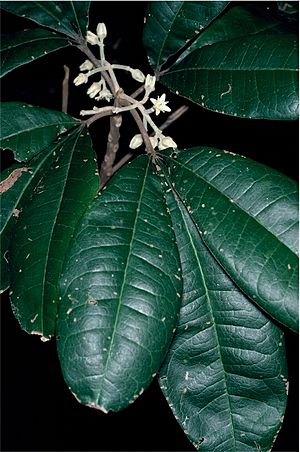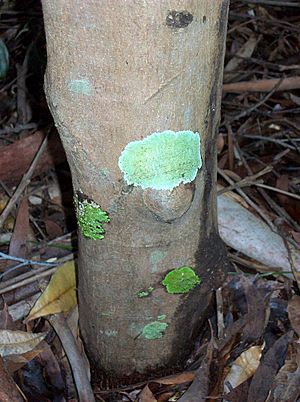Hairy acronychia facts for kids
Quick facts for kids Hairy aspen |
|
|---|---|
 |
|
| Acronychia pubescens in Coffs Harbour | |
| Scientific classification | |
| Genus: |
Acronychia
|
| Species: |
pubescens
|
| Synonyms | |
|
|
The Hairy Aspen (Acronychia pubescens) is a special type of tall shrub or small tree. It's also known as hairy acronychia. This plant grows only in eastern Australia, which means it is endemic there.
It usually has leaves made of three parts, called trifoliate leaves. Sometimes, its leaves are simple, with just one part. The Hairy Aspen also has groups of whitish flowers. These flowers grow in the axils of the leaves, which are the spots where the leaf meets the stem. After flowering, the plant produces creamy or yellowish fruits that are shaped like an oval or a ball.
Contents
What the Hairy Aspen Looks Like
The Hairy Aspen can grow quite tall, up to about 15 meters (50 feet) high. Its main stem, or trunk, can be around 18 centimeters (7 inches) wide. The trunk is usually round, but sometimes it has wider parts, like small supports, at its base.
The bark of the tree is grayish-brown and feels fairly smooth. The smaller branches are golden in color and covered with soft, fine hairs. This hairiness is a key feature that helps tell this plant apart from other similar species.
Leaves and Flowers
The leaves of the Hairy Aspen grow in pairs, opposite each other on the stem. Most of the time, each leaf is made up of three smaller leaflets, making it a trifoliate leaf. These leaflets can be shaped like a spear, an oval, or an egg. They are usually between 5 and 26 centimeters (2 to 10 inches) long and 1.8 to 7.7 centimeters (0.7 to 3 inches) wide.
Each leaflet sits on a small stalk called a petiolule, which can be up to 2.3 centimeters (0.9 inches) long. The whole leaf is attached to the branch by a longer stalk called a petiole, which can be 0.8 to 8.5 centimeters (0.3 to 3.3 inches) long. The top side of the leaflets feels a bit fuzzy, especially along the middle vein. The underside of the leaflets is even hairier.
The flowers grow in small clusters called cymes, which are 2.5 to 6.5 centimeters (1 to 2.5 inches) long. These clusters appear in the leaf axils. Each flower has a tiny stalk, or pedicel, that is 1 to 4.5 millimeters long. The flowers have four small green parts called sepals, which are 1.5 to 2.5 millimeters wide. They also have four greenish-fawn petals that are 6 to 9 millimeters long. Inside the flower, there are eight stamens, which are the parts that produce pollen.
Fruit and Seeds
You can find flowers and fruits on the Hairy Aspen almost all year round. The fruit is a fleshy, hairy, and ridged drupe, which is a type of fruit with a hard pit inside, like a peach. It's shaped like an oval or a ball and is creamy to yellowish in color. The fruit is 1.2 to 1.8 centimeters (0.5 to 0.7 inches) long. It has a taste that some describe as acidic or like turpentine.
Inside the fruit, there can be up to three dark grey or black seeds. These seeds are about 4 to 4.5 millimeters long and look a bit like tiny canoes.
Where the Hairy Aspen Grows
The Hairy Aspen grows in a specific area of eastern Australia. You can find it from Urunga in northern New South Wales all the way up to the Blackall Range in southeastern Queensland.
This tree likes to grow in several different types of rainforests. It can be found in subtropical rainforests, especially where the soil is red or brown and made from basalt rock. It also grows in rainforests near the coast and along rivers. The Hairy Aspen is most commonly seen in warm temperate rainforests that are located at higher altitudes.
Growing Hairy Aspen at Home
If you want to grow Hairy Aspen, it's best to remove the fleshy part of the fruit from the seeds before planting them. About half of the seeds might sprout, but it can take up to seven months for them to do so. You can also try growing new plants from cuttings.
When growing Hairy Aspen, it needs soil that drains well, meaning water doesn't sit around its roots. However, it does benefit from extra water and fertilizer to help it grow strong. Even though the fruits are edible, their turpentine-like taste means they are not usually eaten by people.
How the Hairy Aspen Got Its Name
The Hairy Aspen was first described in 1891 by a botanist named Frederick Manson Bailey. He gave it the name Melicope pubescens. He wrote about it in a publication called the Botany Bulletin after finding it in the Blackall Range.
Later, in 1939, his grandson, Cyril Tenison White, who was also a botanist, reclassified the plant. He gave it its current scientific name, Acronychia pubescens. This new name was published in the Proceedings of the Royal Society of Queensland. The word pubescens in its name means "hairy," which refers to the soft, downy hairs on its leaves.


